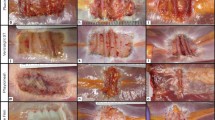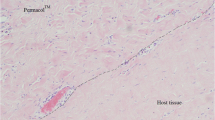Abstract
The tissue reaction to implanted monofilamentous and multifilamentous polypropylene mesh was compared in samples removed at operation from the perivaginal area of a 58 year old patient. The fibrils of both were surrounded by collagenous connective tissue, collagen types I and III, and proteoglycans. Smaller, less compacted bundles were seen in the vicinity of the monofilamentous mesh than around the multifilamentous mesh, and in addition, a greater number of inflammatory cells and larger multinucleate giant cells were seen apposed to the monofilamentous mesh.
Following this, eight rats were implanted with multifilamentous synthetic polypropylene tape and examined at two, four, six and eight weeks after surgery. Macrophages and multinucleated giant cells were seen in the immediate vicinity of the fibrils, while fibrovascular connective tissue surrounded the implantation site.
These observations do not support the prevailing hypotheses that macrophages cannot penetrate between the fibrils of multifilament tape. They do suggest that differences in tensile strength may be present in the artificial neoligaments created by the two tapes.


Similar content being viewed by others
References
Yamada H (1970) Mechanical properties of urogenital organs and tissues. In: Evans FG (ed) Strength of biological materials. Williams & Wilkins Co., Baltimore, MD, pp 205–218, 272–280
Petros PE, Ulmsten U, Papadimitriou J (1990) The Autogenic Neoligament procedure: a technique for planned formation of an artificial neo-ligament. Acta Obstet Gyn Scan Suppl 153(69):43–51
Amid PK (1997) Classification of biomaterials and their related complications in abdominal wall hernia surgery. Hernia 1:15–21
Papadimitriou JM, Ashman RB (1989) Macrophages: current views on their differentiation, structure and function. Ultrastruct Path 13:343–358
Peyrat L, Boutin JM, Bruyere F, Haillot O, Fakfak H, Lanson Y (2001) Intestinal perforation as a complication of tension-free vaginal tape procedure for urinary incontinence. Eur Urol 39(5):603–5
Koelbl H, Stoerer S, Seliger G, Wolters M (2001) Transurethral penetration of a tension-free vaginal tape. Brit J Obstet Gynaec (2001) 108:7 763
Rechberger T, Rzezniczuk K, Skorupski P, Adamiak A, Tomaszewski J et al. (2003) A randomized comparison between monofilament and multifilament tapes for stress incontinence surgery. Int J Urogynecol 14:432–436
Ulmsten U, Henriksson L, Johnson P, Varhos G (1996) An ambulatory surgical procedure under local anesthesia for treatment of female urinary incontinence. Int Urogynecol J 7:81–86
Coda A, Botto-Micca F, Quaglino F, Ramellini G (2000) In vivo tissue reaction to different prosthetic materials in abdominal wall hernia repair. Hernia 4:206–211
Greca FH, de Paula JB, Biondo-Simões MLP, da Costa FD, da Silva APG, Time S, Mansur A (2001) The influence of differing pore sizes on the biocompatibility of two polypropylene meshes in the repair of abdominal defects. Experimental study in dogs. Hernia 5:59–64
Coda A, Bendavid R, Botto-Micca F, Bossotti M, Bona A (2003) Structural alterations of prosthetic meshes in humans. Hernia 7:29–34
Deligiannidis N, Papavasiliou I, Sapalidis K, Kesisoglou I, Papavramidis S, Gamvros O (2002) The use of three different mesh materials in the treatment of abdominal wall defects. Hernia 6:51–55
Author information
Authors and Affiliations
Corresponding author
Rights and permissions
About this article
Cite this article
Papadimitriou, J., Petros, P. Histological studies of monofilament and multifilament polypropylene mesh implants demonstrate equivalent penetration of macrophages between fibrils. Hernia 9, 75–78 (2005). https://doi.org/10.1007/s10029-004-0286-6
Received:
Accepted:
Published:
Issue Date:
DOI: https://doi.org/10.1007/s10029-004-0286-6




